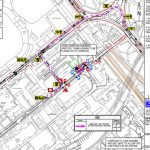Guide to Traffic Control Plan and Traffic Management Plan
It’s not safe to work around traffic that isn’t well managed. If you’re in charge of a business or project, you need to make a plan to keep people safe. This plan should control how traffic flows and reduce the risk of accidents. It’s called a traffic management plan.
- What is a Traffic Management Plan?
- What is the Purpose of a Traffic Management Plan?
- Work Health and Safety (WHS) Responsibilities
- Managing Traffic Risks
- Identify Traffic Hazards
- Assessing All Traffic Risks
- Risk Control Measures for Traffic Management
- Safe Work Method Statements for Traffic Management
- A Traffic Control Plan (TCP)
- Traffic Management Plan vs Traffic Control Plan
- Where to Use TMPs and TCPs?
A traffic management plan is a way of organising how people and things move around in a certain area. It involves thinking about all the different types of traffic, like cars, bikes, and people walking. The goal is to make sure everything moves safely and efficiently. The traffic management plan has different parts, like figuring out the best routes for each type of traffic and putting in measures to control how it all moves.
It’s important to think about all the potential problems and make traffic management plans to avoid them, even for small things that might cause big problems. A traffic management plan helps keep everyone safe and things running smoothly.
A traffic management plan helps keep people safe when they’re at work by making sure that traffic moves safely. It helps traffic flow smoothly and makes it easy for people to get around. This traffic management plan helps prevent accidents from happening and makes sure that people walking and driving can do it safely.
It also helps companies do what they’re supposed to do according to the law.
The WHS Act demands everyone to keep the workplace safe. If you are a PCBU, a principal contractor, designer, manufacturer, supplier, or installer of machinery, material, or constructions, you have specific duties under the Act.
As a PCBU, you need to keep workers secure and safe by discussing with them about the potential risks and cooperating with others responsible. You must also follow applicable traffic management laws and ensure that workers are represented and have necessary mobility equipment.
If you don’t take it seriously, you might face consequences. Hence, it’s necessary to abide by the law, understand your obligations, and create a traffic management plan.
Traffic management is about keeping people safe by managing traffic. It doesn’t matter if you are working on a construction site, in a warehouse, or a busy office, it is important to keep an eye out for potential hazards and take steps to reduce the risks.
Part of taking care of health and safety at work is identifying hazards, assessing them, and controlling traffic risks. There are various things you can do to control traffic risks and keep people safe.
There are many potential dangers that could hurt employees at work. One danger is traffic. This means cars and trucks driving near where workers are, or people walking where there are vehicles. Traffic dangers can lead to injuries or even death if not managed properly. To keep workers safe from these dangers, you need to think about how the workplace is set up and how people and vehicles move around in it.
You should check if there are things that could block someone’s view, like walls or other structures. You should also see if there are places where there is a lot of traffic, which can be dangerous. It’s important to mark areas for loading and unloading and to make sure vehicles park in the right places. This will keep everyone safe.
Workplace safety is of utmost importance for every employer. In order to achieve this, it is imperative to conduct thorough risk evaluations to identify any potential hazards that may cause harm to the employees.
There are various risks associated with workplace safety, but one of the most common risks is traffic hazards. It is crucial for employers to assess the traffic flow in the area, including the speed and quantity of traffic. Additionally, the layout and nature of the workplace and the type of work being conducted must be considered while evaluating traffic risks.
By doing so, employers can develop effective strategies to mitigate the risks and prevent any accidents or injuries. In conclusion, risk evaluation is an integral part of maintaining a safe workplace environment and taking necessary steps to ensure the well-being of all employees.
To keep people safe at work, you need to use the best safety methods. Safe Work Australia recommends a “hierarchy of controls”. There are four levels of control.
- The first level is eliminating hazards. For example, removing vehicles from a work area.
- The second level is finding safer options or keeping dangerous areas isolated from workers.
- The third level is making rules and providing training to reduce risk.
- The last level is using Personal Protective Equipment like hard hats, earplugs, safety glasses and high visibility clothing.
The employer must make sure the workplace is safe. They can use these controls to remove or lower risks for employees, contractors, and site visitors.
Before starting construction on or near a public road, it’s important to evaluate the risks involved. This kind of work is dangerous because vehicles can cause injuries. Therefore, a safe method statement called SWMS is necessary. These statements are vital for traffic management plans.
They explain the work to be done, the dangers involved, and how traffic will be controlled to keep risks low. It’s important to create a SWMS before starting any job that could be dangerous to workers, and it should be checked and updated as needed.
A traffic control plan (TCP) is a document that explains how to manage traffic and emergencies in a workplace. It can also be a picture showing how to use road signs and devices safely to direct traffic.
TCP helps keep people safe when there are construction zones or other hazards. Traffic controls include give way signs, warnings, speed limits, traffic cones, barricades, traffic controllers, roundabouts, traffic lights, one-way streets, and pedestrian crossings.
TCP helps people use these controls to guide traffic.
A traffic management plan is a comprehensive and detailed set of instructions developed to manage vehicular and pedestrian traffic effectively, efficiently, and safely. The aim of a traffic management plan is to ensure there is minimal disruption, inconvenience or delays to pedestrians and motorists while maintaining a safe and secure environment. The traffic management plan considers factors such as the number of vehicles on the road, the capacity of the infrastructure, and the location of major events or activities that may impact both pedestrian and vehicular traffic flow.
One crucial element of a traffic management plan is the traffic control plan- a subset of the overall plan that focuses on managing the movement and direction of vehicles. The traffic control plan involves delineating traffic routes, installing temporary barriers, signage, and traffic signal controls. The goal of the traffic control plan is to ensure that drivers, pedestrians, and bicyclists are all safe and segregated from one another. Therefore, a well-designed traffic management plan and traffic control plan work in harmony to guide drivers and pedestrians, reduce traffic congestion and minimize accidents.
Construction sites can be extremely hectic and chaotic places, with numerous construction workers, heavy machinery, and construction materials scattered around. Additionally, there are many vehicles constantly moving around the site, including trucks carrying materials and equipment, as well as individuals driving personal vehicles to and from work. All of this can make moving around the site difficult and dangerous.
As a result, it’s essential to have a well-organized and comprehensive traffic management plan and control plan in place. This involves identifying designated routes for different types of vehicles, ensuring that there are clear signs and signals in place to direct traffic flow, and regularly communicating with workers and visitors about the importance of safe traffic management practices.
By implementing effective traffic management and control plans, businesses and workplaces can significantly reduce the risks associated with vehicular traffic on their construction sites. Not only does this make the site safer for workers, but it can also help to protect visitors and vehicles passing by the site.






Comments are closed.